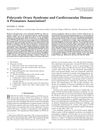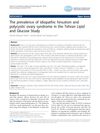
Search
for
Sort by
Research
360-390 / 1000+ results

research Comprehensive Overview of Polycystic Ovary Syndrome
Polycystic Ovary Syndrome (PCOS) is a common condition in women that can cause metabolic, reproductive, and psychological issues, and requires lifestyle changes and medication for management.

research Polycystic Ovary Syndrome and Cardiovascular Disease: A Premature Association?
While PCOS might increase the risk of heart disease, there's not strong evidence to prove it causes earlier heart problems.

research Metabolic Features of the Reproductive Phenotypes of Polycystic Ovary Syndrome
Women with the NIH type of PCOS have more obesity and higher risk of diabetes and heart disease than those with other types of PCOS.

research The Rotterdam Study: 2014 Objectives and Design Update
The Rotterdam Study aims to understand disease causes in the elderly and has found new risk factors and genetic influences on various conditions.

research Polycystic Ovary Syndrome: Comprehensive Overview
PCOS is a complex disorder in women that can lead to various health risks and requires personalized treatment.

research Adverse Side Effects of 5α-Reductase Inhibitors Therapy: Persistent Diminished Libido, Erectile Dysfunction, and Depression in a Subset of Patients
Some patients taking finasteride or dutasteride may have ongoing sexual problems and depression even after stopping the medication.

research Polycystic Ovary Syndrome, Insulin Resistance, and Obesity: Navigating the Pathophysiologic Labyrinth
Insulin resistance and obesity are key factors in the development and worsening of polycystic ovary syndrome, and lifestyle changes are important for managing it.

research Medical Treatments for Male and Female Pattern Hair Loss
Minoxidil and finasteride treat hair loss in men, while minoxidil treats hair loss in women.

research Androgen Receptor Antagonists Structure-Activity Relationships
Antiandrogens like flutamide are effective in treating conditions like prostate cancer and hair loss, but there's a need for more potent versions. Understanding their structure can help develop better treatments.

research Cutaneous Complications of Chemotherapeutic Agents
Chemotherapy can cause skin problems like hair loss, mouth sores, and skin darkening, and recognizing these can affect treatment decisions.

research Early Inductive Events in Ectodermal Appendage Morphogenesis
Early development of hair, teeth, and glands involves specific signaling pathways and cellular interactions.

research TRP Channels in Skin Biology and Pathophysiology
TRP channels in the skin are important for sensation and health, and targeting them could help treat skin disorders.

research Markers of Epidermal Stem Cell Subpopulations in Adult Mammalian Skin
The document concludes that adult mammalian skin contains multiple stem cell populations with specific markers, important for understanding skin regeneration and related conditions.

research Primary Cicatricial Alopecia: Treatment Approaches and Classification
Treatments for permanent hair loss from scarring aim to stop further loss, not regrow hair, and vary by condition, with partial success common.

research Polycystic Ovary Syndrome: Overview and Management
PCOS is a common hormonal disorder in women, marked by symptoms like hair growth and menstrual issues, and requires personalized treatment.

research Lichen Planopilaris and Frontal Fibrosing Alopecia as Model Epithelial Stem Cell Diseases
Lichen Planopilaris and Frontal Fibrosing Alopecia may help us understand hair follicle stem cell disorders and suggest new treatments.

research Expression Patterns of Three Estrogen Receptor Genes During Zebrafish Development: Evidence for High Expression in Neuromasts
The three estrogen receptor genes are highly expressed in zebrafish neuromasts during development.

research Ovarian Hypertension: Polycystic Ovary Syndrome
Polycystic Ovary Syndrome is linked to higher risk of hypertension and heart disease.

research AGD1, A Class 1 ARF-GAP, Acts in Common Signaling Pathways with Phosphoinositide Metabolism and the Actin Cytoskeleton in Controlling Arabidopsis Root Hair Polarity
AGD1 is important for root hair development in Arabidopsis, working with phosphoinositide signaling and the actin cytoskeleton.

research Male Androgenetic Alopecia
DHT, a testosterone byproduct, causes male pattern baldness.

research The Prevalence of Idiopathic Hirsutism and Polycystic Ovary Syndrome in the Tehran Lipid and Glucose Study
About 13% of women had idiopathic hirsutism and 8.5% had polycystic ovary syndrome in a group of Iranian women.

research High Resolution Full Scan Liquid Chromatography Mass Spectrometry Comprehensive Screening in Sports Antidoping Urine Analysis
The method effectively detects banned substances in urine for sports antidoping.

research Polycystic Ovary Syndrome: A Common But Often Unrecognized Condition
Polycystic Ovary Syndrome is common but often undiagnosed, and early treatment is important to prevent health problems.

research Controllable Production of Transplantable Adult Human High-Passage Dermal Papilla Spheroids Using 3D Matrigel Culture
Researchers created hair-inducing human cell clusters using a 3D culture method.

research Prevalence of CYP21 Mutations and IRS1 Variant Among Women With Polycystic Ovary Syndrome and Adrenal Androgen Excess
Some women with PCOS have CYP21 mutations and IRS1 variants, but these genetic factors are not major contributors to PCOS.

research Topical Melatonin for Treatment of Androgenetic Alopecia
Melatonin solution helps treat hair loss in men and women.

research Shorter CAG Repeats in the Androgen Receptor Gene May Enhance Hyperandrogenicity in Polycystic Ovary Syndrome
Shorter CAG repeats in a specific gene may increase male hormone activity and symptoms like acne and excess hair in women with PCOS.

research Vitamin D Receptor Polymorphisms and Polycystic Ovary Syndrome: A Systematic Review
The review found no clear link between vitamin D receptor gene variations and polycystic ovary syndrome.

research Hidradenitis Suppurativa in Children and Adolescents: A Review of Treatment Options
More pediatric-specific research and guidelines are needed to improve hidradenitis suppurativa treatment in children and adolescents.